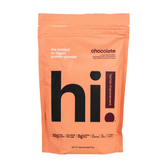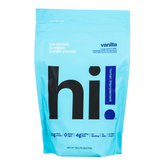Skip the skimming, here’s a summary of the main takeaways:
We all need protein.
+ Protein is a must-have nutrient that supports your body in nearly every way (the structure, function, and regulation of your tissues and organs).
The only way to get all the protein you need is through your food.
+ Only a complete protein like cricket protein has a complete amino acid profile to give your body all the nutrients it needs. It’s also important to eat a variety of plant and animal-based protein sources like crickets, peas, brown rice, and pumpkin seeds.
Cricket protein powder is one of the most nutrient-dense protein sources on the planet.
+ Not only are they high in protein, but also fiber, healthy fats, vitamins and minerals, and prebiotics for gut health.
Choosing a sustainable protein is essential to reduce your environmental footprint.
+ Animal-based food production contributes over two-thirds of all agriculture greenhouse gas emissions. Reduce your footprint by choosing more sustainable protein sources such as cricket or plant-based proteins found in Human Improvement Protein Powder.
We all need protein. In fact, it’s necessary for our survival. But what exactly is it, how much do you need, and what are the healthiest sources? We’re diving into all this and more, including the protein you can find in our Human Improvement Protein Powders:
Chocolate Protein Powder
The easiest to digest. Learn More.What is protein?
Protein is an essential macronutrient made up of over 20 different kinds of basic building blocks called amino acids. They’re called “building blocks” because protein makes up most of the cells in your body including your skin, hair, muscles, and bones1.
Protein also helps keep you full throughout the day, gives you energy, supports your digestion, helps you recover from a tough workout by building back your muscle tissue, among many other benefits2. In other words, you can’t exist without it.
Complete vs. incomplete protein
Protein can be absorbed through your food or made in the body. However, nine of those 20 amino acids — called “essential amino acids” — have to come from your food1. A complete protein source contains all nine of these essential amino acids. An incomplete protein source is missing one or a few.
As you might guess, it’s important to get all the amino acids, especially those extra essential ones, that your body needs. Most animal-based proteins such as meat, fish, and dairy are complete protein sources. Most plant-based proteins are incomplete protein sources. However, a combination of plant-based proteins can also create a complete protein source5.
Improvement Tip: When you think “protein” it’s not uncommon for meat to be the first thing that comes to mind. But turns out that over 75% of Americans are eating too much meat, poultry, and eggs4. Try and lower your meat consumption for healthier sources of protein like pumpkin, pea, cricket, or brown rice found in Human Improvement Protein Powder.How much protein do you need?
Protein is pretty important. But how much should you eat? While it varies from person to person, the average recommendation is 0.36 grams of protein per pound of body weight per day3. This means if you’re a 170-pound person, you need around 60 grams of protein each day. But if you live a more active lifestyle, you’ll need even more.
How to choose healthy protein
With most foods, especially protein, the best principle is quality over quantity. But if you can get high quality and quantity, that’s even better.
For example, a 4-ounce sirloin steak is a complete protein source with over 33g of protein. But it also has over 5 grams of saturated fat1. The grocery aisles are also overflowing with “high protein” products that claim to be good for you. While the popularized “protein cookies” have 16g of protein, they also contain nearly the same amount of sugar (12g). Plus loads of highly processed oils, gut-harming ingredients, fillers, gums, and other synthetic components.
Even with a high protein content, if you’re giving your body unhealthy and heavily-processed “ingredients” with tons of sugar, the bad often outweighs the good. The best way to get the protein you need — without all the unwanted extras — is to eat a variety of nutritious plant and animal-based protein sources. This way you’re getting all nine essential amino acids, plus the fiber, vitamins, and minerals you need to support your overall health. P.S. the protein you choose also needs to feel right for you and your body!
Here are some high-protein healthy options to choose from:
- Crickets
- Beans
- Peas
- Nuts and seeds
- Fish
- Poultry
- Lentils
- Low-fat dairy products
- Leafy green vegetables (such as spinach or kale)
- Whole grains (quinoa, brown rice, oats, etc.)
Improvement Tip: Human Improvement Protein Powder contains 22 grams of protein from pumpkin, brown rice, pea, and cricket protein powder that blend together for a complete — and delicious! — source of high-quality protein. Plus it’s super easy to digest, meaning you’ll feel good while supplying your body with all the essential amino acids it needs. (Minus the sugar, sodium, or saturated fats you might find in other protein sources!)Sustainable protein
There's another element to protein that we don’t always talk about and that’s sustainability. Agriculture, especially animal-based agriculture, is a huge contributor to deforestation, species extinction, freshwater depletion and contamination, and greenhouse gas emissions (GHG)1.
While all forms of food production place demand on our natural resources, animal-based agriculture comes in at number one. Animal-based food production accounts for more than 75% of global agriculture and two-thirds of all agricultural greenhouse gases while only contributing 37% of the protein6. After all, animals need land, food, and waste disposal before they make it to our plate. And all these resources add up!
When you check out this graph from the Food and Agriculture Organization (FAO), you can see that beef and pigs produce far more greenhouse gases than some of the most popular edible insects.

Image source: FAO
The same goes for animal vs. plant-based food sources. In this graph from the World Resources Institute, beef generates about five times more greenhouse gas emissions than chicken and over 30 times more than wheat or rice.
Image source: World Resource Institute
So what can we do about it? One thing we can all do is reach for more sustainable food sources. To be sustainable, a protein source must meet our nutritional needs within planetary boundaries. In other words, a sustainable protein must be healthy for humans and the planet.
Improvement Tip: So how can you be more sustainable with your food consumption? Here are some ideas: (1) Cut out or reduce your consumption of red meats (2) Reduce your food waste by only buying what you need (3) Introduce or try a protein source that’s better for your body and the planet.Protein Powder
So here’s the situation: we’re eating too much unsustainable meat-based protein. And a lot of that meat is leading to some unwanted impacts on both the planet and our bodies. Luckily, protein powder like Human Improvement Protein can not only help change that story but can also add in extra protein if you’re living a more active lifestyle.
But not all protein powders are created equal. Here are the pros and cons of some types of protein that you might find in a protein powder:
Soy
Made from soybeans, soy protein is a complete plant-based protein source and a common ingredient in protein powders7. As a dairy-free protein source, it's a popular choice for vegans and those with dairy sensitivities. Plus, it’s a far more sustainable protein solution than animal-based products.
However, soy is a controversial protein source due to its potential risks of estrogenic hormone disruptions in the body8. And some studies say that soy is not as effective as other protein sources in supporting your muscle tissue growth7. Whey One of the most popular sources of protein in a protein powder is whey, a complete protein source that’s easily absorbed by your body9. The downside to whey is that it comes from dairy10. Whey protein powder comes from cow’s milk and is 11-15% protein, 63-75% lactose or milk sugar, and 1-2% milk fat7.
Whey
Aside from being less sustainable, this also means that too much whey protein, like any other dairy product, can result in some gut discomfort such as bloating or constipation, especially if you have dairy allergies or sensitivities10. Pumpkin seed Pumpkin seeds are incredibly high in fiber and nutrients such as unsaturated fatty acids, magnesium, phosphorus, iron, potassium, and copper12. They’re also loaded with antioxidants, which help reduce inflammation and protect against certain diseases12. So on top of their high protein content, they’re also an incredibly nutritious and sustainable plant-based food source.
Pumpkin seed
Pumpkin seed protein is not a complete protein though because it’s low in the essential amino acids threonine and lysine11. But when complemented with other protein sources — like pea, brown rice, and cricket protein found in Human Improvement Protein Powder! — it offers a complete protein solution. Brown rice Brown rice protein contains natural BCAAs (branched-chain amino acids ) in a high concentration, which helps your body to grow stronger muscles13. This makes brown rice protein a great sustainable plant-based protein source in a protein powder, especially before or after a workout.
Brown rice
As a protein source, brown rice almost qualifies as a complete protein but it’s too low on lysine and threonine to make the cut13. However, brown rice protein is one of the higher plant-based protein sources, with over 79% protein content14. Pea Just like brown rice protein, pea protein is an incredibly high plant-based protein source with around 80% protein content14. In one study they found that pea protein was right in line with whey protein for both fast absorption and quick feelings of fullness15.
Pea
Made from yellow split peas, pea protein powder is also rich in BCAAs but it’s too low in methionine to pass as a complete protein source7. However, it’s high in lysine and threonine so when blended with brown rice and pumpkin seed protein in Human Improvement Protein Powder, for example, it creates a complete protein solution. Cricket Cricket protein powder is a great source of high-quality and sustainable protein. Notably, crickets have a higher percentage of protein than beef, chicken, or even salmon. Crickets consist of 65-70% protein (in both their whole and powder form) and are a complete protein on their own16. In 100 grams of cricket, you’ll find around 40 to 75 grams of protein. Beef only has 43 grams and chicken 31 grams17!
Cricket
When it comes to taste and texture, most people are pleasantly surprised. Cricket protein is smooth and nearly flavorless, with an almost nutty taste most closely resembling almonds or cashews. The easiest way to try cricket protein for the first time is in a powdered form that can either be baked or blended into beverages like a smoothie or shake.
And we’ve paired our Human Improvement cricket protein with coconut milk, flaxseed, cocoa powder, and pink Himalayan salt for a delicious and irresistible blend that has a velvety smooth texture — unlike the chalky taste of other protein powders. Why cricket protein powder? Cricket protein powder is one of the most nutrient-dense protein sources on the planet. It’s not only high in protein but packed with fiber, healthy fats, and vitamins and minerals including calcium, potassium, zinc, magnesium, copper, folate, biotin, pantothenic acid, and iron18 19.
But the number one reason people love cricket protein powder is for its easy digestion and zero bloating, a common complaint you’ll see in other protein powders like whey protein. This is thanks to prebiotic fibers like chitin and chitosan that help keep your gut microbiome healthy18.
What also makes cricket protein stand apart is that it’s one of the most sustainable protein sources. Insects use far less land, water, and resources than conventional livestock farming. They need six times less feed than cattle, four times less than sheep, and two times less than pigs and chickens to produce the same amount of protein20.
And remember all those greenhouse gases from cows? Crickets release 80 times fewer greenhouse 17. What protein powder is best for you? According to Landyn Saputo, Health Coach and Smoothie Artist, the important qualities of a protein powder include: All-natural, organic ingredients Enough protein (~20g per serving is a good baseline) No refined sugars Delicious taste A variety of protein sources for a complete protein solution
Human Improvement Protein Powder checks all the boxes (especially, the good taste!). By combining cricket protein with a blend of organic pumpkin, pea, and brown rice protein as well as other functional ingredients like flaxseed and psyllium husk powder, Human Improvement has created a one-of-a-kind protein supplement.
Not only is it high in protein and fiber — 22 grams of protein and 5g of fiber per serving — but also dairy-free, lactose-free, soy-free, incredibly easy to digest, and high in B12, fiber, iron, and many other vitamins and minerals. All without any added sugar.
While other protein powders cause bloating, this is a gut-supporting blend loaded with prebiotics and fiber to promote healthy gut bacteria. And best of all, not only is it incredibly good for you, but it’s good for the planet.
Shop our protein today and check out the Museum of Smoothies for a ton of great ideas to add Human Improvement protein powders into your daily routine.
Sources
1) https://www.hsph.harvard.edu/nutritionsource/what-should-you-eat/protein/ 2) https://medlineplus.gov/genetics/understanding/howgeneswork/protein/ 3) https://pubmed.ncbi.nlm.nih.gov/26797090/ 4) https://www.dietaryguidelines.gov/sites/default/files/2020-12/Dietary_Guidelines_for_Americans_2020-2025.pdf 5) https://www.medicalnewstoday.com/articles/321474 6) https://www.wri.org/data/animal-based-foods-are-more-resource-intensive-plant-based-foods 7) https://www.hsph.harvard.edu/nutritionsource/workout-supplements/ 8) https://www.hsph.harvard.edu/nutritionsource/soy/ 9) https://pubmed.ncbi.nlm.nih.gov/24800664/ 10) https://www.mayoclinic.org/drugs-supplements-whey-protein/art-20363344 11) https://fdc.nal.usda.gov/fdc-app.html#/food-details/553577/nutrients 12) https://www.webmd.com/diet/health-benefits-pumpkin-seeds#1 13) https://www.ncbi.nlm.nih.gov/pmc/articles/PMC5302255/ 14) https://www.ncbi.nlm.nih.gov/pmc/articles/PMC6245118/ 15) https://www.ncbi.nlm.nih.gov/pmc/articles/PMC4400298/ 16) https://www.ncbi.nlm.nih.gov/pmc/articles/PMC6582163/ 17) https://www.theatlantic.com/politics/archive/2014/04/eat-a-cricket-save-the-world/452844/ 18) https://www.healthline.com/nutrition/eating-crickets#why-eat-them 19) https://www.ncbi.nlm.nih.gov/pmc/articles/PMC7835793/ 20) https://www.fao.org/3/i3264e/i3264e00.pdf











